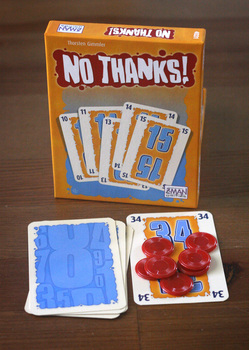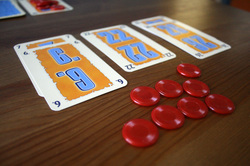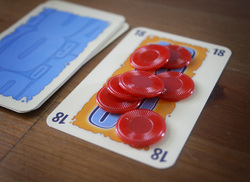No Thanks: The card game that makes me say 'yes please'

Mike Hulsebus | Contributor
No Thanks is a card game so simple that you might already have the cards that you need to play a game around your house right now. I can always appreciate a simple, easy-to-teach diversionary game, but what makes No Thanks special is that the game has enough interesting decisions so it makes not only a good family game but also a good gamer game if you like push-your-luck style choices.
No Thanks comes with a deck of cards numbered 3-35 and a bag of little chips. If you already own Rack-O (or 6 Nimmit if you’re more gamer-y), you can go find those numbered cards and grab some coins to act as chips. Now grab some players and let’s get started.
Rules: Here’s all you need to know to play. The object of the game is to get as few points as possible. Chips are worth -1 point and everyone (3-5 players) starts with 11 chips. The cards are shuffled and 9 cards are removed from the deck without looking at them and set aside for this round. The remaining cards form the deck that will be used in the game.
Then the first player flips over the top card of the deck. It is worth points equal to the number on the card (and remember, points are bad). If the player doesn’t want the card, he puts a chip on that card. The next player can choose to either take the card and the chip, or add another chip to it and keep sending it around until finally someone decides that he wants to take the card and all the chips on it. If a player runs out of chips, he is forced to take the card on his turn.

A smart player will have to balance out taking risks and making sure that he has enough chips not to be forced to take cards.
Mike Hulsebus | Contributor
The clever thing about scoring is that if you can get a sequence of numbers (e.g. you take 20-21-22 or 13-14), that sequence is only worth points equal its lowest number So rather than taking 90 points, the above example would be worth 33 points (20+13). At the end of the game, players total up their scores and whoever has the least points wins.
Review: It’s simple, yes, but it’s not a game that you can play on autopilot like many card games. The great thing about No Thanks is that you can decide how far you want to push your luck. Let’s say that I have already taken the 29-point card and the 28-point card comes up on my turn. Yes, I could just take it right away and benefit from the fact that my cards would be a sequence, but I’m likely better off if I put a chip on it. No one else is going to voluntarily take 28 points, so I can continue to let it go around the circle letting the negative point chips stack up until I take it. But I have to make sure I don’t let it go around too long, or someone else may take it for the chips.
Chips, obviously, are valuable because they’re worth negative points, but their other value comes in allowing you to not take a card you don’t want. So if there’s a 25-point card out there with negative 10 points in chips on it, someone might take that card, even though they’ve gained 15 net points. It may be saving them later from taking more points if their chips run low. I’ve played in a game where someone ran out of chips, and it wasn’t pretty.

As the chips stack up, players will find themselves increasingly tempted to take the card for its chips.
Mike Hulsebus | Contributor
Another great thing about the game is that 9 cards are removed from the game at the start. So if you already have captured, say, the 15-point card and a 17-point card comes up, you’re not going to know for sure if it will later be possible to claim a 16-point card since it might not even be in this round’s deck.
Anyone can make a really balanced game. Uno is a very fair and balanced game because everyone’s drawing from the same deck. No Thanks, however, is not only balanced, but also well designed. A well-designed game stands out because there are enough little interesting things going on to give you tricky decisions and for there to be gray area in what a “correct” decision is for a given situation. For that, I would definitely recommend No Thanks as a good quick card game.

